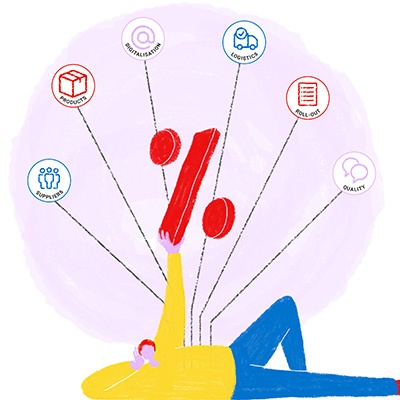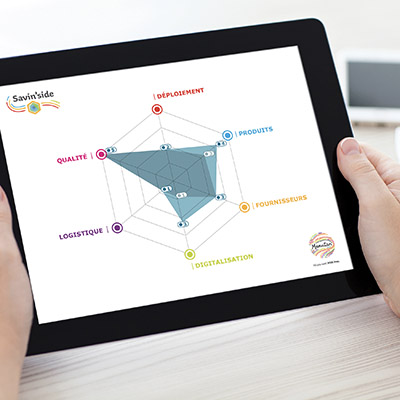Circular economy is generating increasing interest from economic stakeholders. Companies see it as a powerful lever to reconcile their economic, environmental, and social challenges. And for good reason – circular business models help preserve natural resources and reduce the impact on the environment while making intelligent cost savings. In this dynamic, procurement departments have a major role to play in integrating circular economy principles into their practices. However, they face significant challenges in effective implementation, as this remains an emerging market. Pierre-Emmanuel Saint-Esprit, Circular Economy Director at Manutan Group, shares his insights on circular economy challenges for procurement teams.
Circular economy challenges: The availability of circular supply
Today, the linear economy is predominant. In other words, the market for new products can be considered mature. Supply is abundant and well-structured, subject to intense competition. As such, procurement departments have plenty of choices when selecting their suppliers, determining their specifications and, ultimately, purchasing products that meet their company’s needs.
It’s quite different for the circular economy. "To date, the global economy is only 7.2% circular according to the latest circularity gap report published by Circle Economy. This represents a tiny fraction of materials that go through a reuse or recycling phase after their first use," notes Pierre-Emmanuel Saint-Esprit. Especially since this figure has been steadily declining for nearly five years.
From a procurement perspective, this means that circular supply remains underdeveloped. Whether for raw materials or finished products, finding a circular option in the market can be less straightforward. In some cases, certain sectors don’t exist yet. In others, they are operational but produce limited quantities. This can then hold back companies that need to purchase in volume.
Faced with this issue, procurement departments must deploy all their talent to explore the market, identify potential partners and challenge them on their offers. To make their approach concrete, they would also do well to adopt the step-by-step strategy. This involves setting realistic objectives and implementing simple actions. For example, during a development project, they can set circular criteria for some of the products they wish to purchase, mixing new and circular supply as needed.
Circular economy challenges: The quality of circular supply
In opting for the circular economy, procurement departments also face the quality issue. This is particularly the case when purchasing reconditioned products, for example.
Remember that a reconditioned product is fully functional, as it has been tested, restored and repackaged by a professional. It usually comes with a detailed product sheet, duration warranty, after-sales service, positive impact assessment of the approach, etc. Gradually, a legal framework is beginning to take shape around the reconditioned market and circular economy initiatives are emerging. This is the case, for example, with the RECQ label (Reconditioning Quality) which controls the quality of certain types of reconditioned products. However, there are not yet officially recognised certifications for all reconditioned products.
To ensure product quality, buyers must therefore work with trusted reconditioners. These can be two types of players: Pure players who are market references or recognised companies developing their own circular supply. Attention must be paid to product documentation that specifies the condition of use and lists functionalities that have been repaired and/or tested.
Pierre-Emmanuel Saint-Esprit emphasises: "To go even further, the procurement team can even visit the reuse centre of their partner. It’s by going into the field, meeting operators and observing processes that they can thus ensure the reliability of operations."
Circular economy challenges: Internal customer satisfaction
When a procurement department moves towards the circular economy, they must also ensure internal customer satisfaction. This is actually a subject intrinsically linked to product quality whether concerning efficiency or aesthetics. To achieve this, procurement departments must support change. This involves informing, raising awareness and educating internal customers about circular procurement.
First, this relies on collaboration. Buyers must work hand in hand with business units to co-construct specifications, challenge them on integrating circular criteria and align their respective objectives. And this, upstream of any procurement project.
Next, it’s important to legitimise the approach. For this, you need to be able to evaluate the impacts and communicate all the advantages it represents. The idea is to show how the circular economy fits into your company’s CSR strategy and roadmap, with supporting figures. For example, you can highlight the financial savings made, the quantity of raw materials saved, the greenhouse gas emissions that have been reduced, etc. Pierre-Emmanuel Saint-Esprit adds: "This implies that the supplier is able to share this data, then buyers put it into perspective and make it tangible. It can be interesting to convert carbon emissions into a measure everyone understands, like a Paris-New York round trip which corresponds to 1 tonne of CO2 equivalent, for example."
Circular economy challenges: Regulatory compliance
Lastly, the ultimate circular economy challenge for companies wishing to integrate this economic model into their supply chain is compliance. Regulations supporting the circular economy are multiplying worldwide. While Japan made the first efforts in the 1990s, the European Union and its Member States are actively participating in this now global dynamic. Today, regulations concern limiting resource consumption, but also improving resource efficiency, waste management and recycling, extended producer responsibility and eco-design.
To meet compliance challenges, it falls to procurement departments to stay informed of all regulatory developments. Companies that are most advanced in this area could even anticipate these future requirements and thus gain a key competitive advantage.
To trigger the circular transition, procurement departments must overcome certain challenges. However, this market is booming and solutions should become increasingly easier to implement. In this perspective, we must not forget that the procurement function plays a key role in initiating this strategic shift. Buyers challenge their company’s needs, select suppliers and thus influence the existing market. They therefore have all the cards in hand to promote sustainability within their organisation and beyond its walls.









